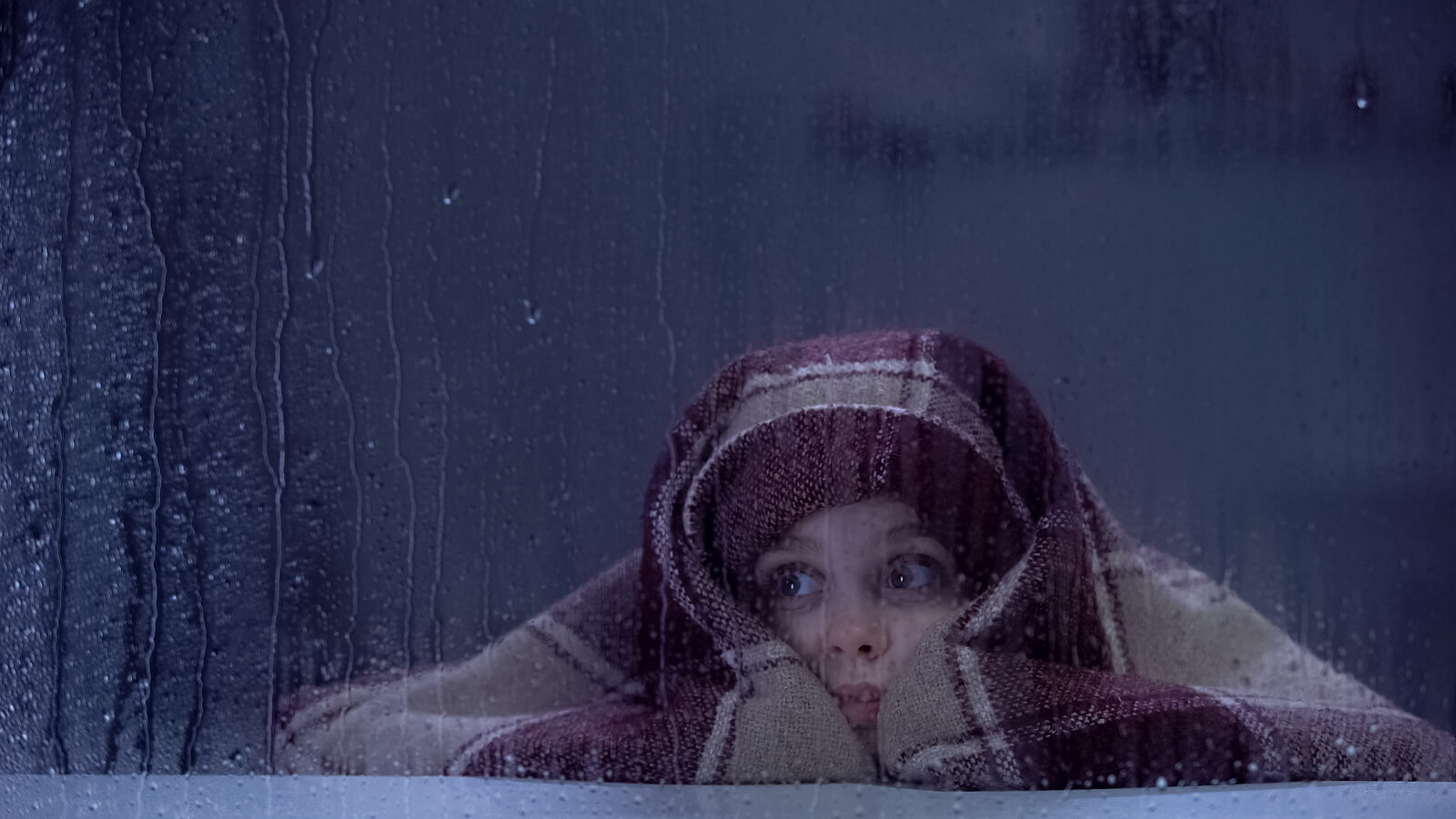Why do Teenagers Like Scary Movies?

It’s cousins’ night or perhaps a get-together with friends. The plan is pizza, snacks, ice cream, and horror movies, and whoever covers their eyes during the scariest scene loses. We can all tell stories about these experiences from our adolescence because it seems that, during the teenage years, this plan is repeated across the globe. However, why is it that while every day we avoid things that scare us, we love a good fright when it comes to movies? If you’re interested in knowing why teenagers like scary movies, be sure to read this article.
Why do teenagers like scary movies?
Perhaps adolescence is the time of greatest consumption of horror movies, but this doesn’t imply that the genre isn’t enjoyed at other ages. Below, we’re going to tell you some of the reasons that science has to suggest about these creepy preferences.
Variables related to adolescence

Some research links the characteristics of adolescence in relation to scary movies: It suggests that adolescents seek intense experiences that challenge them.
When we watch scary movies, this primary and primitive emotion is activated, which predisposes our bodies to flee as a matter of survival. And, therefore, it increases the release of adrenaline in the blood.
In turn, in their search for identity, adolescents try to challenge themselves and determine how much they’re able to tolerate. This is another way of marking the transition from childhood to adulthood, which is very important for them. After all, from the time they’re little they wait for that time when they’re “grown up” in order to be able to enjoy scary movies at the theater.
At the same time, it’s been suggested that horror movies favor group socialization because when they end, adolescents exchange experiences and share laughs about their fears and reactions.
Variables are present at all ages, including adolescence
Some studies document that the preference for scary movies is related to the subsequent sensation they produce: A pleasant experience of relief and well-being.
Scary movies have different stimuli (sound, sudden appearances, tricks with lights) that create an intense climate and keep viewers in a state of alertness. Then, when the situation is resolved, the stress disappears and gives way to the enjoyment of calm.
Finally, there’s also research that focuses on the response to the genre based on the characteristics of each person’s personality. For example, Professor Marvin Zuckerman of the University of Delaware suggested that some people are more oriented to the search for intense sensations, so they are interested in coming into contact with certain exciting experiences.
Therefore, the personality variable can also be associated with the preference of adolescents for scary movies.
As we can see, psychology can guide us with regard to different questions. However, there will always be several factors involved in their choices.
Scary movies as an educational resource
Movies can serve families as an opportunity to work on approaching and managing emotions. For example, if we watch a horror movie with teenagers, we can then take the opportunity to invite them to discuss how they felt, why a certain situation made them feel the way they did, or how they handled their fear.
This way, emotions can be explored and help young people find ways to deal with their fears and worries. Emphasize the positive aspects of fear and prevent it from being seen only as a negative emotion.
In turn, watching scary movies is an opportunity to get to know themselves, as it confronts adolescents with some of their feared situations, often kept to themselves, and allows them to “rehearse” how they would resolve them.
At the same time, another topic that can also be worked on is empathy, as this type of movie allows teens to identify in some sense with certain characters and reject others.

Some guidelines regarding scary movies
Finally, it’s good for parents to be attentive to the scary movies that teenagers watch because some of them have bloody scenes, gender violence, sexual encounters, substance abuse, among others. If these issues haven’t been raised at home, these titles may not be appropriate for them to watch alone.
In this sense, scary movies can be a good opportunity to talk with children about certain topics and point out some values or desired behaviors. For example, don’t penalize sexual relations or point them out as something negative, but give children the appropriate guidelines regarding care and respect for themselves and for others.
It’s also advisable to check that there are no unprocessed issues after the movie, as this may trigger some concern, fear, or phobia and manifest itself through insomnia or nightmares, anxiety, or anxiety crises.
It’s cousins’ night or perhaps a get-together with friends. The plan is pizza, snacks, ice cream, and horror movies, and whoever covers their eyes during the scariest scene loses. We can all tell stories about these experiences from our adolescence because it seems that, during the teenage years, this plan is repeated across the globe. However, why is it that while every day we avoid things that scare us, we love a good fright when it comes to movies? If you’re interested in knowing why teenagers like scary movies, be sure to read this article.
Why do teenagers like scary movies?
Perhaps adolescence is the time of greatest consumption of horror movies, but this doesn’t imply that the genre isn’t enjoyed at other ages. Below, we’re going to tell you some of the reasons that science has to suggest about these creepy preferences.
Variables related to adolescence

Some research links the characteristics of adolescence in relation to scary movies: It suggests that adolescents seek intense experiences that challenge them.
When we watch scary movies, this primary and primitive emotion is activated, which predisposes our bodies to flee as a matter of survival. And, therefore, it increases the release of adrenaline in the blood.
In turn, in their search for identity, adolescents try to challenge themselves and determine how much they’re able to tolerate. This is another way of marking the transition from childhood to adulthood, which is very important for them. After all, from the time they’re little they wait for that time when they’re “grown up” in order to be able to enjoy scary movies at the theater.
At the same time, it’s been suggested that horror movies favor group socialization because when they end, adolescents exchange experiences and share laughs about their fears and reactions.
Variables are present at all ages, including adolescence
Some studies document that the preference for scary movies is related to the subsequent sensation they produce: A pleasant experience of relief and well-being.
Scary movies have different stimuli (sound, sudden appearances, tricks with lights) that create an intense climate and keep viewers in a state of alertness. Then, when the situation is resolved, the stress disappears and gives way to the enjoyment of calm.
Finally, there’s also research that focuses on the response to the genre based on the characteristics of each person’s personality. For example, Professor Marvin Zuckerman of the University of Delaware suggested that some people are more oriented to the search for intense sensations, so they are interested in coming into contact with certain exciting experiences.
Therefore, the personality variable can also be associated with the preference of adolescents for scary movies.
As we can see, psychology can guide us with regard to different questions. However, there will always be several factors involved in their choices.
Scary movies as an educational resource
Movies can serve families as an opportunity to work on approaching and managing emotions. For example, if we watch a horror movie with teenagers, we can then take the opportunity to invite them to discuss how they felt, why a certain situation made them feel the way they did, or how they handled their fear.
This way, emotions can be explored and help young people find ways to deal with their fears and worries. Emphasize the positive aspects of fear and prevent it from being seen only as a negative emotion.
In turn, watching scary movies is an opportunity to get to know themselves, as it confronts adolescents with some of their feared situations, often kept to themselves, and allows them to “rehearse” how they would resolve them.
At the same time, another topic that can also be worked on is empathy, as this type of movie allows teens to identify in some sense with certain characters and reject others.

Some guidelines regarding scary movies
Finally, it’s good for parents to be attentive to the scary movies that teenagers watch because some of them have bloody scenes, gender violence, sexual encounters, substance abuse, among others. If these issues haven’t been raised at home, these titles may not be appropriate for them to watch alone.
In this sense, scary movies can be a good opportunity to talk with children about certain topics and point out some values or desired behaviors. For example, don’t penalize sexual relations or point them out as something negative, but give children the appropriate guidelines regarding care and respect for themselves and for others.
It’s also advisable to check that there are no unprocessed issues after the movie, as this may trigger some concern, fear, or phobia and manifest itself through insomnia or nightmares, anxiety, or anxiety crises.
All cited sources were thoroughly reviewed by our team to ensure their quality, reliability, currency, and validity. The bibliography of this article was considered reliable and of academic or scientific accuracy.
- Perez, V., García, A. (2005). Análisis funcional de las estrategias psicológicas de terror en el cine. Estudios de Psicología, 26 (2), 237-245.
- Andrade, Eduardo B. and Cohen, Joel, On the Consumption of Negative Feelings. Journal of Consumer Research, October 2007, Available at SSRN: https://ssrn.com/abstract=892028
- Spielberg, J. M., Olino, T. M., Forbes, E. E., & Dahl, R. E. (2014). Exciting fear in adolescence: does pubertal development alter threat processing?. Developmental cognitive neuroscience, 8, 86–95. https://doi.org/10.1016/j.dcn.2014.01.004
This text is provided for informational purposes only and does not replace consultation with a professional. If in doubt, consult your specialist.








